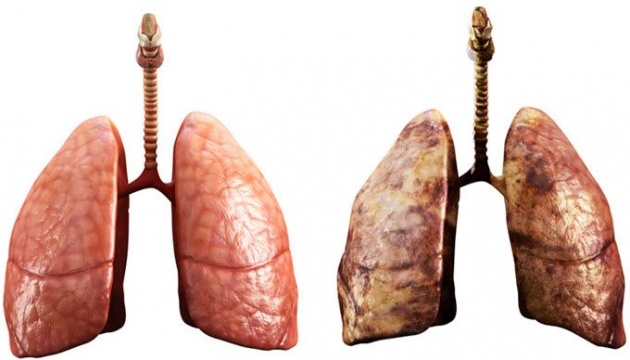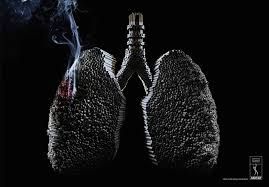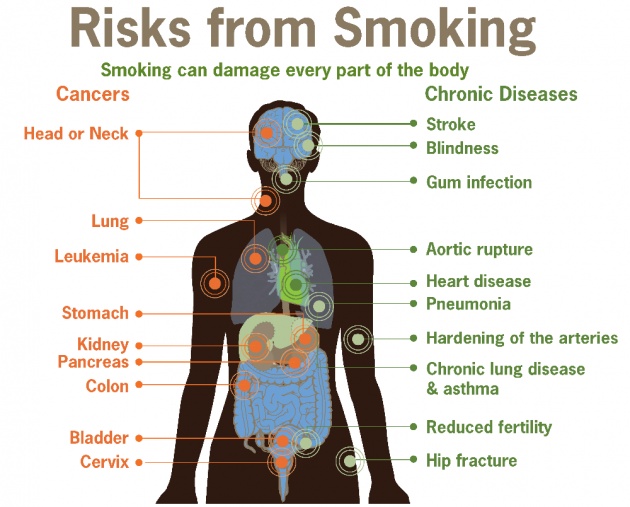
Smoking is a practice in which a substance is burned and the resulting smoke breathed in to be tasted and absorbed into the bloodstream. Most commonly the substance is the dried leaves of the tobacco plant which have been rolled into a small square of rice paper to create a small, round cylinder called a "cigarette". Smoking is primarily practiced as a route of administration for recreational drug usebecause the combustion of the dried plant leaves vaporizes and delivers active substances into the lungs where they are rapidly absorbed into the bloodstream and reach bodily tissue. In the case of cigarette smoking these substances are contained in a mixture of aerosol particles and gasses and include the pharmacologically active alkaloid nicotine; the vaporization creates heated aerosol and gas to form that allows inhalation and deep penetration into the lungs where absorption into the bloodstream of the active substances occurs. In some cultures, smoking is also carried out as a part of various rituals, where participants use it to help induce trance-like states that, they believe, can lead them to "spiritual enlightenment".

Cigarettes are primarily industrially manufactured but also can be hand-rolled from loose tobacco and rolling paper. Other smoking implements include pipes, cigars,bidis, hookahs, vaporizers, and bongs.
Smoking generally has adverse health effects, because smoke inhalation inherently poses challenges to various physiologic processes such as respiration. Diseases related to tobacco smoking have been shown to kill approximately half of long term smokers when compared to average mortality rates faced by non-smokers. A 2007 report states that, each year, about 4.9 million people worldwide die as a result of smoking.[1]
Smoking is one of the most common forms of recreational drug use. Tobacco smoking is the most popular form, being practiced by over one billion people globally, of whom the majority are in the developing world.[2] Less common drugs for smoking include cannabis and opium. Some of the substances are classified as hard narcotics, like heroin, but the use of these is very limited as they are usually not commercially available.
The history of smoking can be dated to as early as 5000 BC, and has been recorded in many different cultures across the world. Early smoking evolved in association with religious ceremonies; as offerings to deities, in cleansing rituals or to allowshamans and priests to alter their minds for purposes of divination or spiritual enlightenment. After the European exploration and conquest of the Americas, the practice of smoking tobacco quickly spread to the rest of the world. In regions like India and Sub-Saharan Africa, it merged with existing practices of smoking (mostly of cannabis). In Europe, it introduced a new type of social activity and a form of drug intake which previously had been unknown.

Perception surrounding smoking has varied over time and from one place to another: holy and sinful, sophisticated and vulgar, a panacea and deadly health hazard. In the 20th century smoking came to be viewed in a decidedly negative light, especially in Western countries. This is due to smoking tobacco being among the leading causes of many diseases such aslung cancer, heart attacks, COPD, erectile dysfunction, and birth defects.[2] The health hazards of smoking have caused many countries to institute high taxes on tobacco products, run ads to discourage use, limit ads that promote use, and provide help with quitting for those who do smoke.

The history of smoking dates back to as early as 5000 BC in shamanistic rituals.[3]Many ancient civilizations, such as the Babylonians, Indians and Chinese, burnt incense as a part of religious rituals, as did the Israelites and the later Catholic and Orthodox Christian churches. Smoking in the Americas probably had its origins in the incense-burning ceremonies of shamans but was later adopted for pleasure, or as a social tool.[4] The smoking of tobacco, as well as various hallucinogenic drugs was used to achieve trances and to come into contact with the spirit world.
Substances such as Cannabis, clarified butter (ghee), fish offal, dried snake skins and various pastes molded around incense sticks dates back at least 2000 years. Fumigation (dhupa) and fire offerings (homa) are prescribed in the Ayurveda for medical purposes, and have been practiced for at least 3,000 years while smoking,dhumrapana (literally "drinking smoke"), has been practiced for at least 2,000 years. Before modern times these substances have been consumed through pipes, with stems of various lengths or chillums.[5]

Cannabis smoking was common in the Middle East before the arrival of tobacco, and was early on a common social activity that centered around the type of water pipe called a hookah. Smoking, especially after the introduction of tobacco, was an essential component of Muslim society and culture and became integrated with important traditions such as weddings, funerals and was expressed in architecture, clothing, literature and poetry.[6]
Cannabis smoking was introduced to Sub-Saharan Africa through Ethiopia and the east African coast by either Indian or Arab traders in the 13th century or earlier and spread on the same trade routes as those that carried coffee, which originated in the highlands of Ethiopia.[7] It was smoked in calabash water pipes with terra cotta smoking bowls, apparently an Ethiopian invention which was later conveyed to eastern, southern and central Africa.

Reports from the first European explorers and conquistadors to reach the Americas tell of rituals where native priests smoked themselves into such high degrees of intoxication that it is unlikely that the rituals were limited to just tobacco.[8]
Popularization
For more about the impact and development of tobacco, see History of tobacco.
For more about the commercial development of tobacco, see History of commercial tobacco in the United States.

A Persian girl smoking byMuhammad Qasim. Isfahan, 17th century
In 1612, six years after the settlement of Jamestown, John Rolfe was credited as the first settler to successfully raise tobacco as a cash crop. The demand quickly grew as tobacco, referred to as "golden weed", revived the Virginia join stock company from its failed gold expeditions.[9] In order to meet demands from the old world, tobacco was grown in succession, quickly depleting the land. This became a motivator to settle west into the unknown continent, and likewise an expansion of tobacco production.[10] Indentured servitude became the primary labor force up untilBacon's Rebellion, from which the focus turned to slavery.[11] This trend abated following the American revolution as slavery became regarded as unprofitable. However the practice was revived in 1794 with the invention of the cotton gin.[12]
A Frenchman named Jean Nicot (from whose name the word nicotine is derived) introduced tobacco to France in 1560. From France tobacco spread to England. The first report of a smoking Englishman is of a sailor in Bristol in 1556, seen "emitting smoke from his nostrils".[13] Like tea, coffee and opium, tobacco was just one of many intoxicants that was originally used as a form of medicine.[14] Tobacco was introduced around 1600 by French merchants in what today is modern-dayGambia and Senegal. At the same time caravans from Morocco brought tobacco to the areas around Timbuktu and the Portuguese brought the commodity (and the plant) to southern Africa, establishing the popularity of tobacco throughout all of Africa by the 1650s.

Soon after its introduction to the Old World, tobacco came under frequent criticism from state and religious leaders. Murad IV, sultan of the Ottoman Empire 1623-40 was among the first to attempt a smoking ban by claiming it was a threat to public morality and health. The Chongzhen Emperor of China issued an edict banning smoking two years before his death and the overthrow of the Ming dynasty. Later, the Manchu rulers of the Qing dynasty, would proclaim smoking "a more heinous crime than that even of neglecting archery". In Edo period Japan, some of the earliest tobacco plantations were scorned by theshogunate as being a threat to the military economy by letting valuable farmland go to waste for the use of a recreational drug instead of being used to plant food crops.[15]
Bonsack's cigarette rolling machine, as shown on U.S. patent 238,640.
Religious leaders have often been prominent among those who considered smoking immoral or outright blasphemous. In 1634 the Patriarch of Moscow forbade the sale of tobacco and sentenced men and women who flouted the ban to have their nostrils slit and their backs whipped until skin came off their backs. The Western church leader Urban VII likewise condemned smoking in a papal bull of 1590. Despite many concerted efforts, restrictions and bans were almost universally ignored. WhenJames I of England, a staunch anti-smoker and the author of A Counterblaste to Tobacco, tried to curb the new trend by enforcing a whopping 4000% tax increase on tobacco in 1604, it proved a failure, as London had some 7,000 tobacco sellers by the early 17th century. Later, scrupulous rulers would realise the futility of smoking bans and instead turned tobacco trade and cultivation into lucrative government monopolies.[16]

By the mid-17th century every major civilization had been introduced to tobacco smoking and in many cases had already assimilated it into its culture, despite the attempts of many rulers to stamp the practice out with harsh penalties or fines. Tobacco, both product and plant, followed the major trade routes to major ports and markets, and then on into the hinterlands. The English language term smoking was coined in the late 18th century; before then the practice was referred to as drinking smoke.[13]
Tobacco and cannabis were used in Sub-Saharan Africa, much like elsewhere in the world, to confirm social relations, but also created entirely new ones. In what is today Congo, a society called Bena Diemba ("People of Cannabis") was organized in the late 19th century in Lubuko ("The Land of Friendship"). The Bena Diemba were collectivist pacifists that rejected alcohol and herbal medicines in favor of cannabis.[17]
The growth remained stable until the American Civil War in 1860s, from which the primary labor force transition from slavery to share cropping. This compounded with a change in demand, lead to the industrialization of tobacco production with the cigarette. James Bonsack, a craftsman, in 1881 produced a machine to speed the production of cigarettes.[18]
Opium
Main article: Opium
An illustration of an opium den on the cover of Le Petit Journal, July 5, 1903.
In the 19th century the practice of smoking opium became common. Previously it had only been eaten, and then primarily for its medical properties. A massive increase in opium smoking in China was more or less directly instigated by the British trade deficit with Qing dynasty China. As a way to amend this problem, the British began exporting large amounts of opium grown in the Indian colonies. The social problems and the large net loss of currency led to several Chinese attempts to stop the imports which eventually culminated in the First and Second Opium Wars.[19]
Opium smoking later spread with Chinese immigrants and spawned many infamous opium dens in China towns around South and Southeast Asia and Europe. In the latter half of the 19th century, opium smoking became popular in the artistic community in Europe, especially Paris; artists' neighborhoods such as Montparnasse and Montmartre became virtual "opium capitals". While opium dens that catered primarily to emigrant Chinese continued to exist in China Towns around the world, the trend among the European artists largely abated after the outbreak of World War I.[19] The consumption of Opium abated in China during theCultural revolution in the 1960s and 1970s.

Anti-tobacco movement
For more about the movement in the 1930s and 1940s, see Anti-tobacco movement in Nazi Germany.
For more about the modern movement, see Anti-smoking movement.
For more about the development of public policy, see Tobacco politics.
With the modernization of cigarette production compounded with the increased life expectancies during the 1920s, adverse health effects began to become more prevalent.[citation needed] In Germany, anti-smoking groups, often associated with anti-liquor groups,[20] first published advocacy against the consumption of tobacco in the journal Der Tabakgegner (The Tobacco Opponent) in 1912 and 1932. In 1929, Fritz Lickint of Dresden, Germany, published a paper containing formal statistical evidence of a lung cancer–tobacco link. During the Great Depression, Adolf Hitler condemned his earlier smoking habit as a waste of money,[21] and later with stronger assertions. This movement was further strengthened with Nazi reproductive policy as women who smoked were viewed as unsuitable to be wives and mothers in a German family.[22]
The movement in Nazi Germany did reach across enemy lines during the Second World War, as anti-smoking groups quickly lost popular support.[clarification needed] By the end of the Second World War, American cigarette manufacturers quickly reentered the German black market. Illegal smuggling of tobacco became prevalent,[23] and leaders of the Nazi anti-smoking campaign were assassinated.[24] As part of the Marshall Plan, the United States shipped free tobacco to Germany; with 24,000 tons in 1948 and 69,000 tons in 1949.[23] Per capita yearly cigarette consumption in post-war Germany steadily rose from 460 in 1950 to 1,523 in 1963.[25] By the end of the 20th century, anti-smoking campaigns in Germany were unable to exceed the effectiveness of the Nazi-era climax in the years 1939–41 and German tobacco health research was described by Robert N. Proctor as "muted".[25]
A lengthy study conducted in order to establish the strong association necessary for legislative action.
In the UK and the USA, an increase in lung cancer rates, formerly "among the rarest forms of disease", was noted by the 1930s, but its cause remained unknown and even the credibility of this increase was sometimes disputed as late as 1950. For example, in Connecticut, reported age-adjusted incidence rates of lung cancer among males increased 220% between 1935–39 and 1950-54. In the UK, the share of lung cancer among all cancer deaths in men increased from 1.5% in 1920 to 19.7% in 1947. Nevertheless, these increases were questioned as potentially caused by increased reporting and improved methods of diagnosis. Although several carcinogens were already known at the time (for example, benzo[a]pyrenewas isolated from coal tar and demonstrated to be a potent carcinogen in 1933), none were known to be contained in adequate quantities in tobacco smoke.[26]Richard Doll in 1950 published research in the British Medical Journal showing a close link between smoking and lung cancer.[27] Four years later, in 1954 the British Doctors Study, a study of some 40 thousand doctors over 20 years, confirmed the link, based on which the government issued advice that smoking and lung cancer rates were related.[28][29] In 1964 the United States Surgeon General's Report on Smoking and Health demonstrated the relationship between smoking and cancer.[30] Further reports confirmed this link in the 1980s and concluded in 1986 that passive smoking was also harmful.[31]
As scientific evidence mounted in the 1980s, tobacco companies claimed contributory negligence as the adverse health effects were previously unknown or lacked substantial credibility. Health authorities sided with these claims up until 1998, from which they reversed their position. The Tobacco Master Settlement Agreement, originally between the four largest US tobacco companies and the Attorneys General of 46 states, restricted certain types of tobacco advertisement and required payments for health compensation; which later amounted to the largest civil settlement in United States history.[32]
From 1965 to 2006, rates of smoking in the United States have declined from 42% to 20.8%.[33] A significant majority of those who quit were professional, affluent men. Despite this decrease in the prevalence of consumption, the average number of cigarettes consumed per person per day increased from 22 in 1954 to 30 in 1978. This paradoxical event suggests that those who quit smoked less, while those who continued to smoke moved to smoke more light cigarettes.[34]This trend has been paralleled by many industrialized nations as rates have either leveled-off or declined. In the developing world, however, tobacco consumption continues to rise at 3.4% in 2002.[35] In Africa, smoking is in most areas considered to be modern, and many of the strong adverse opinions that prevail in the West receive much less attention.[36] Today Russialeads as the top consumer of tobacco followed by Indonesia, Laos, Ukraine, Belarus, Greece, Jordan, and China.[37] The World Health Organization has begun a program known as the Tobacco Free Initiative (TFI) in order to reduce rates of consumption in the developing world..
Other substances
For more about the rise of Crack Cocaine, see Crack epidemic (United States).
In the early 1980s, organized international drug trafficking grew. However, compounded with overproduction and tighter legal enforcement for the illegal product, drug dealers decided to convert the powder to "crack" - a solid, smoke-able form of cocaine, that could be sold in smaller quantities, to more people.[38] This trend abated in the 1990s as increased police action coupled with a robust economy deterred many potential candidates to forfeit or fail to take up the habit.[39]
Recent years shows an increase in the consumption of vaporized heroin, methamphetamine and Phencyclidine (PCP). Along with a smaller number of psychedelic drugs such as DMT, 5-Meo-DMT, and Salvia divinorum.[citation needed]
Substances and equipment
See also: List of drugs which can be smoked
The most popular type of substance that is smoked is tobacco. There are many different tobacco cultivars which are made into a wide variety of mixtures and brands. Tobacco is often sold flavored, often with various fruit aromas, something which is especially popular for use with water pipes, such as hookahs. The second most common substance that is smoked iscannabis, made from the flowers or leaves of Cannabis sativa or Cannabis indica. The substance is considered illegal in most countries in the world and in those countries that tolerate public consumption, it is usually only pseudo-legal. Despite this, a considerable percentage of the adult population in many countries have tried it with smaller minorities doing it on a regular basis. Since cannabis is illegal or only tolerated in most jurisdictions, there is no industrial mass-production of cigarettes, meaning that the most common form of smoking is with hand-rolled cigarettes (often called joints) or with pipes. Water pipes are also fairly common, and when used for cannabis are called bongs.
An elaborately decorated pipe.
A few other recreational drugs are smoked by smaller minorities. Most of these substances are controlled, and some are considerably more intoxicating than either tobacco or cannabis. These include crack cocaine, heroin, methamphetamine and PCP. A small number of psychedelic drugs are also smoked, including DMT, 5-Meo-DMT, andSalvia divinorum.
Even the most primitive form of smoking requires tools of some sort to perform. This has resulted in a staggering variety of smoking tools and paraphernalia from all over the world. Whether tobacco, cannabis, opium or herbs, some form of receptacle is required along with a source of fire to light the mixture. The most common today is by far the cigarette, consisting of a mild inhalant strain of tobacco in a tightly rolled tube of paper, usually manufactured industrially and including a filter, or hand-rolled with loose tobacco. Other popular smoking tools are various pipes and cigars.
A less common but increasingly popular alternative to smoking is vaporizers, which use hot air convection to deliver the substance without combustion, thereby decreasing health risk to the lungs. A portable vaporization alternative appeared in 2003 with the introduction of electronic cigarettes, battery-operated, cigarette-shaped devices which produce an aerosol intended to mimic the smoke from burning tobacco, delivering nicotine to the user without carbon monoxide and other harmful substances released in tobacco smoke. Claims that electronic cigarettes are overall less harmful to use than real cigarettes are, however, disputed[by whom?], as is their legal status in many countries.
Other than actual smoking equipment, many other items are associated with smoking; cigarette cases, cigar boxes, lighters,matchboxes, cigarette holders, cigar holders, ashtrays, silent butlers, pipe cleaners, tobacco cutters, match stands, pipe tampers, cigarette companions and so on. Many of these have become valuable collector items and particularly ornate and antique items can fetch high prices at the finest auction houses.
Health effects and regulation
Smoking can damage every part of the body
Main article: Health effects of tobacco
Smoking is one of the leading causes of preventable death globally. In the United States about 500,000 deaths per year are attributed to smoking-related diseases and a recent study estimated that as much as 1/3 of China's male population will have significantly shortened life-spans due to smoking.[40] Male and female smokers lose an average of 13.2 and 14.5 years of life, respectively.[41] At least half of all lifelong smokers die earlier as a result of smoking.[42][43] The risk of dying from lung cancer before age 85 is 22.1% for a male smoker and 11.9% for a female current smoker, in the absence of competing causes of death. The corresponding estimates for lifelong nonsmokers are a 1.1% probability of dying from lung cancer before age 85 for a man of European descent, and a 0.8% probability for a woman.[44] Smoking one cigarette a day results in a risk of heart disease that is halfway between that of a smoker and a non-smoker. The non-linear dose response relationship is explained by smoking's effect on platelet aggregation.[45]
Among the diseases that can be caused by smoking are vascular stenosis, lung cancer,[46] heart attacks[47] and chronic obstructive pulmonary disease.[48] Smoking during pregnancy may cause ADHD to a fetus.[49]
Many governments are trying to deter people from smoking with anti-smoking campaigns in mass media stressing the harmful long-term effects of smoking. Passive smoking, or secondhand smoking, which affects people in the immediate vicinity of smokers, is a major reason for the enforcement of smoking bans. This is a law enforced to stop individuals smoking in indoor public places, such as bars, pubs and restaurants. The idea behind this is to discourage smoking by making it more inconvenient, and to stop harmful smoke being present in enclosed public spaces. A common concern among legislators is to discourage smoking among minors and many states have passed laws against selling tobacco products to underage customers (establishing a smoking age). Many developing countries have not adopted anti-smoking policies, leading some to call for anti-smoking campaigns and further education to explain the negative effects of ETS (Environmental Tobacco Smoke) in developing countries.[citation needed] Tobacco advertising is also sometimes regulated to make smoking less appealing.
Despite the many bans, European countries still hold 18 of the top 20 spots, and according to the ERC, a market research company, the heaviest smokers are from Greece, averaging 3,000 cigarettes per person in 2007.[50] Rates of smoking have leveled off or declined in the developed world but continue to rise in developing countries. Smoking rates in the United States have dropped by half from 1965 to 2006, falling from 42% to 20.8% in adults.[51]
The effects of addiction on society vary considerably between different substances that can be smoked and the indirect social problems that they cause, in great part because of the differences in legislation and the enforcement of narcotics legislation around the world. Though nicotine is a highly addictive drug, its effects on cognition are not as intense or noticeable as other drugs such as cocaine, amphetamines or any of the opiates (including heroin andmorphine).[citation needed]
Smoking is a risk factor in Alzheimer's disease.[52] While smoking more than 15 cigarettes per day has been shown to worsen the symptoms of Crohn's disease,[53] smoking has been shown to actually lower the prevalence of ulcerative colitis.
Physiology
A graph that shows the efficiency of smoking as a way to absorb nicotine compared to other forms of intake.
Inhaling the vaporized gas form of substances into the lungs is a quick and very effective way of delivering drugs into the bloodstream (as the gas diffuses directly into the pulmonary vein, then into the heart and from there to the brain) and affects the user within less than a second of the first inhalation. The lungs consist of several million tiny bulbs called alveoli that altogether have an area of over 70 m² (about the area of a tennis court). This can be used to administer useful medical as well as recreational drugs such as aerosols, consisting of tiny droplets of a medication, or as gas produced by burning plant material with a psychoactive substance or pure forms of the substance itself. Not all drugs can be smoked, for example the sulphate derivative that is most commonly inhaled through the nose, though purer free base forms of substances can, but often require considerable skill in administering the drug properly. The method is also somewhat inefficient since not all of the smoke will be inhaled.[56] The inhaled substances trigger chemical reactions in nerve endings in the brain due to being similar to naturally occurring substances such as endorphins and dopamine, which are associated with sensations of pleasure. The result is what is usually referred to as a "high" that ranges between the mild stimulus caused by nicotine to the intense euphoria caused by heroin, cocaine and methamphetamines.[57]
Inhaling smoke into the lungs, no matter the substance, has adverse effects on one's health.[citation needed] The incomplete combustion produced by burning plant material, like tobacco or cannabis, produces carbon monoxide, which impairs the ability of blood to carry oxygen when inhaled into the lungs. There are several other toxic compounds in tobacco that constitute serious health hazards to long-term smokers from a whole range of causes; vascular abnormalities such asstenosis, lung cancer, heart attacks, strokes, impotence, low birth weight of infants born by smoking mothers. 8% of long-term smokers develop the characteristic set of facial changes known to doctors as smoker's face.[58]
Tobacco smoke is a complex mixture of over 5,000 identified chemicals, of which 98 are known to have specific toxicologicalproperties.[59] The most important chemicals causing cancer are those that produce DNA damage since such damage appears to be the primary underlying cause of cancer.[60][61] Cunningham et al.[62] combined the microgram weight of the compound in the smoke of one cigarette with the known genotoxic effect per microgram to identify the most carcinogeniccompounds in cigarette smoke. The seven most important carcinogens in tobacco smoke are shown in the table, along with DNA alterations they cause.



